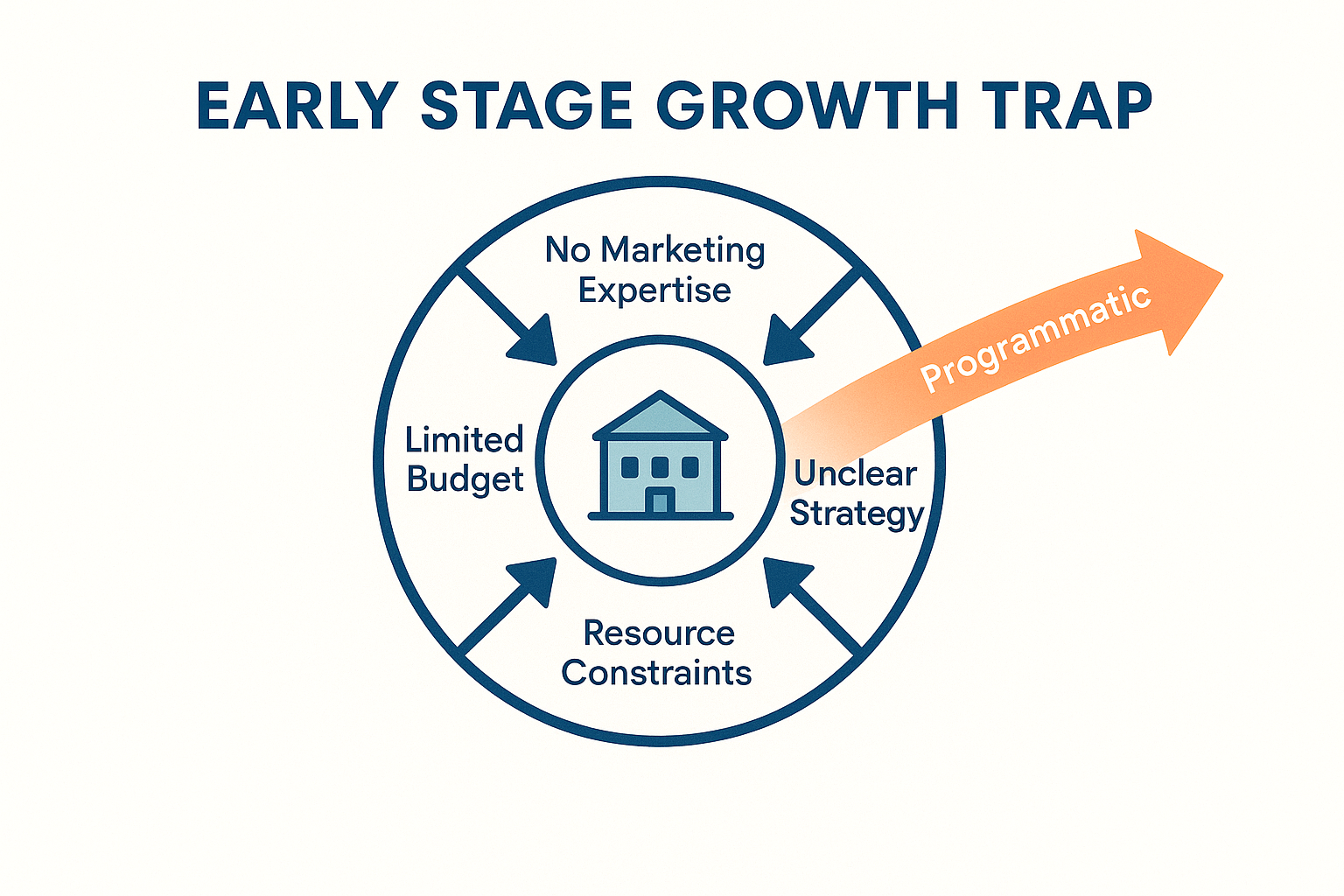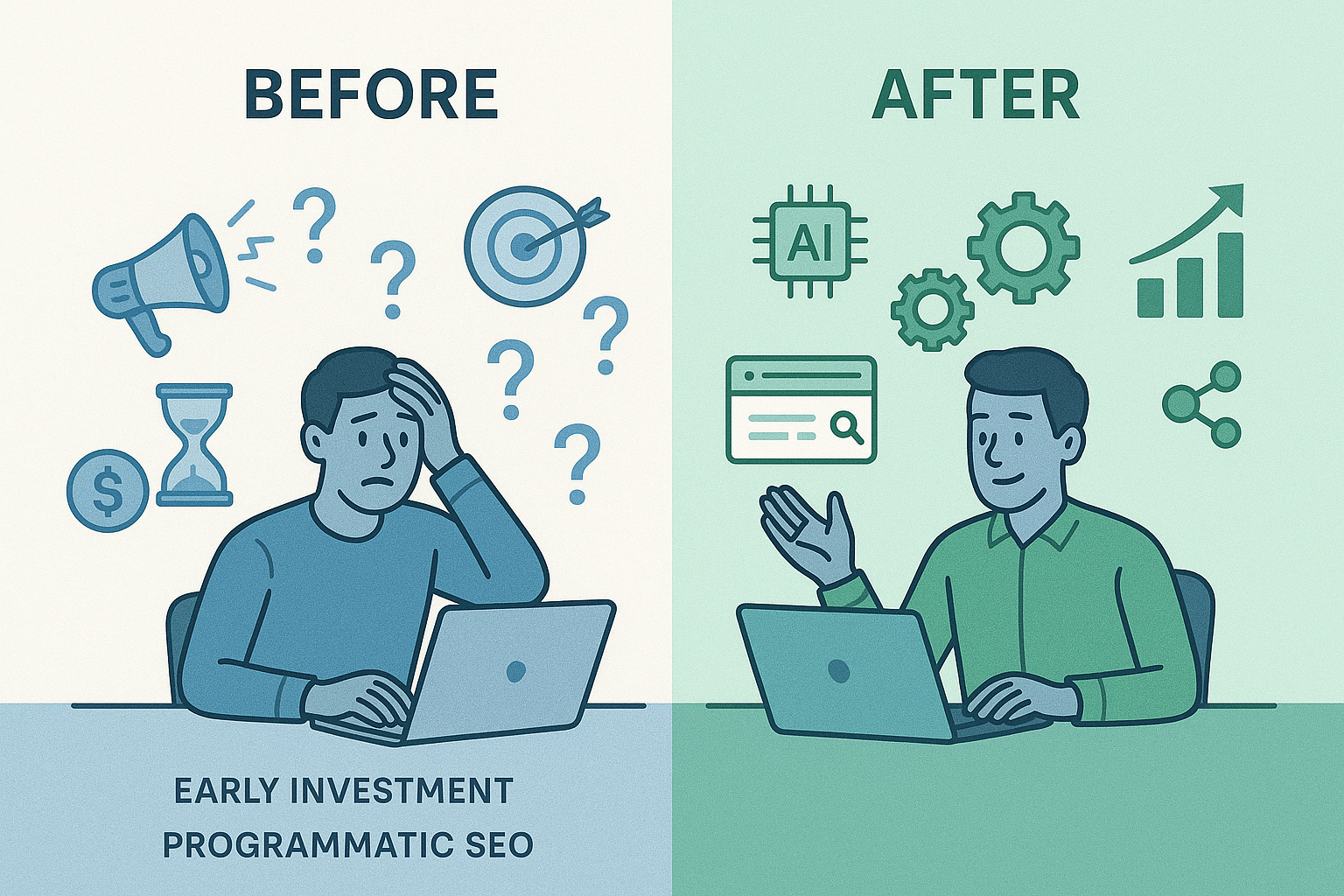And why programmatic SEO might be your secret weapon

You've built something people actually want. Your product works. You've got those first few customers who not only pay you but actually seem excited about what you've created. You're past the "will anyone care about this?" phase and firmly into the "how do I get more people to care about this?" territory.
Congratulations! You've also just entered what I call the Early Stage Growth Trap.
The Worst Phase of Building a Startup
Here's the brutal truth about early-stage growth: it's arguably the hardest phase of building a startup. Not because the technical challenges are insurmountable, but because you're operating with maximum constraints during minimum clarity.
Think about it. You have a product that works and some proof that people want it. But you're stuck in this weird limbo where you need to grow to survive, yet you lack almost everything required to grow effectively. You don't have the marketing expertise, the budget to hire experts, or even the clarity about which channels will work for your specific business.
I've been through this exact scenario multiple times. We had built a solid Customer Identity and Access Management platform, had some initial traction, but were staring at the growth mountain wondering how on earth we were going to scale from a few customers to hundreds, then thousands.
The dilemma is real and it's universal: Do you fumble around trying to do marketing yourself, potentially wasting precious time and money? Or do you blow your limited budget hiring someone who might not even know what they're doing in your specific context?
Why Traditional Marketing Advice Fails Early-Stage Startups
Most marketing advice you'll find is written for companies that already have substantial resources. "Run Facebook ads!" they say. "Hire a content marketing agency!" they suggest. "Build a comprehensive SEO strategy!" they recommend.
All of this advice assumes you have either expertise or money, preferably both. But early-stage startups have neither. You're the founder wearing seventeen different hats, trying to keep the product development moving while somehow also becoming a marketing expert overnight.
Even when you do try to follow conventional wisdom, you often end up in situations where you're not sure if your marketing isn't working because your approach is wrong, your execution is poor, or your timing is off. The feedback loops are slow, the data is limited, and the stakes feel impossibly high.
The Real Problem: You Need Systems, Not Just Tactics
Here's what I learned after going through this painful growth phase multiple times: the solution isn't just finding the right marketing tactic or hiring the right person. The solution is building systems that can work consistently without requiring expertise you don't have or budgets you can't afford.

When we were in the growth phase, I realized that our biggest wins came not from brilliant marketing campaigns, but from creating systems that could generate leads and build our brand even when I was focused on product development or customer success. We needed marketing that could work while we slept, that could scale without constant supervision, and that could build long-term value rather than just generating short-term spikes.
This is where programmatic SEO becomes incredibly powerful for early-stage startups, though most founders don't realize it yet.
Understanding Programmatic SEO: Your Growth Multiplier
Traditional SEO involves manually creating content for keywords you want to rank for. You research keywords, write blog posts, optimize pages, and hope Google notices. It's slow, resource-intensive, and requires consistent expertise.
Programmatic SEO flips this approach. Instead of manually creating content piece by piece, you create systems that can automatically generate hundreds or thousands of pages targeting specific, valuable keywords. Think of it as SEO at scale, powered by automation and data.
The classic example is how Zapier built thousands of integration pages like "Connect Gmail to Slack" or "Connect Salesforce to HubSpot." Each page targets a specific, high-intent keyword, but they didn't manually create each page. They built a system that could generate these pages automatically based on their integration data.
For B2B SaaS companies, this approach is particularly powerful because you can create pages targeting very specific use cases, comparisons, and solutions that your potential customers are actually searching for.
Why This Matters for Your Top-of-Funnel Growth
The beautiful thing about programmatic SEO is that it solves multiple problems early-stage startups face simultaneously.
First, it addresses the expertise problem. You don't need to become an SEO expert overnight. Once you set up the system, it continues working without requiring deep ongoing SEO knowledge. You're essentially building marketing infrastructure rather than running marketing campaigns.
Second, it's cost-effective. Instead of paying for ads or expensive content creation, you're investing in systems that continue generating value over time. The initial setup might require some investment, but the ongoing cost is minimal compared to paid acquisition channels.

Third, it builds long-term value. Every page you create through programmatic SEO becomes an asset that can rank in search engines for months or years. Unlike paid ads that stop working the moment you stop paying, these pages continue attracting visitors and generating leads.
But perhaps most importantly for early-stage startups, programmatic SEO can generate substantial traffic volume quickly. Instead of slowly building up content piece by piece, you can create hundreds of relevant pages that start capturing search traffic across a wide range of keywords.
The Long-Term SEO Strategy Advantage
While programmatic SEO can provide quick wins for your top-of-funnel growth, its real power lies in building long-term SEO authority for your brand.
Search engines love websites that provide comprehensive, useful information about specific topics. When you create hundreds of pages that genuinely help people solve problems related to your product category, you're not just targeting individual keywords – you're building topical authority in your space.
This topical authority becomes incredibly valuable over time. As your programmatic pages gain traffic and engagement, they signal to search engines that your website is a trusted source of information in your industry. This authority then helps all of your other content rank better, including your product pages, blog posts, and landing pages.
I've seen this effect play out across multiple companies. The websites that invest early in comprehensive programmatic SEO don't just get traffic from those specific pages – they see improvements across their entire SEO performance because search engines begin to view them as authoritative sources in their industry.
Making It Work: The Practical Implementation
Now, let me get practical about how you can actually implement this strategy without getting overwhelmed.
The key is starting with your existing data and knowledge. Every B2B SaaS company has information that can be turned into programmatic content. You know your customers' use cases, the problems they're trying to solve, the tools they're comparing you against, and the specific scenarios where your product shines.
Start by identifying the types of pages that would be valuable for your audience and feasible for you to create systematically. This might be comparison pages, use case pages, integration pages, or solution pages for specific industries or roles.
The goal isn't to create perfect pages initially. The goal is to create good-enough pages that provide genuine value and can be improved over time based on actual performance data.
Once you have a clear picture of what types of pages you want to create, you can begin building the systems to generate them. This is where solutions like GrackerAI become incredibly valuable. Instead of trying to build these systems from scratch, you can leverage AI-powered tools specifically designed for B2B SaaS programmatic SEO.
Beyond Just Traffic: Building Real Business Value
The most important thing to understand about programmatic SEO is that it's not just about generating traffic. It's about building a systematic approach to growth that aligns with how your customers actually discover and evaluate solutions.
When someone searches for "best IAM solution for fintech companies" or "how to implement SSO for SaaS applications," they're not just looking for any content. They're looking for specific, actionable information that helps them solve their problem. When your programmatic pages provide this information, you're not just capturing traffic – you're building trust and positioning your company as a knowledgeable solution provider.
This approach works particularly well for B2B SaaS because the buying process is inherently research-driven. Your potential customers spend significant time researching options, comparing features, and understanding implementation requirements before making decisions. Programmatic SEO allows you to be present throughout this research process, providing value at every stage.
The Compound Effect of Early Investment
Here's what makes programmatic SEO particularly powerful for early-stage startups: the compound effect of early investment.
When you implement programmatic SEO early in your company's growth, you're building marketing assets during a time when your competition might not be paying attention to this strategy. The pages you create now will have months or years to gain authority and ranking power while your competitors are still figuring out their basic marketing strategies.

By the time larger competitors wake up to the power of programmatic SEO, you'll already have established positions for hundreds of valuable keywords in your space. This early-mover advantage can provide sustained competitive benefits that become increasingly difficult for competitors to overcome.
Getting Started: Your Next Steps
If you're convinced that programmatic SEO could help solve your early-stage growth challenges, here's how to get started without overwhelming yourself.
Begin by auditing your existing knowledge and data. What do you know about your customers that could be turned into systematic content? What questions do they ask repeatedly? What comparisons do they make? What specific use cases do they have?
Next, research the keyword landscape in your space. Look for patterns in what people are searching for. Pay particular attention to long-tail keywords that are specific to your industry or use case. These are often easier to rank for and more likely to convert than broad, competitive terms.
Start small with a pilot implementation. Choose one type of page that you can create systematically and build the process for generating those pages. This might be as simple as creating comparison pages for your product versus competitors, or use case pages for different industries you serve.
The goal is to prove the concept with a manageable scope before scaling up to hundreds or thousands of pages.
Looking Forward: Building Sustainable Growth
The early stage growth trap is real, but it's not insurmountable. The key is recognizing that you need systems and processes that can work independently of your constant attention and expertise.
Programmatic SEO represents one of the most powerful systems early-stage B2B SaaS companies can implement because it addresses multiple growth challenges simultaneously. It provides a path to generate significant traffic without ongoing paid advertising costs, builds long-term brand authority in your space, and creates marketing assets that continue working even when you're focused on other aspects of building your business.
Most importantly, it gives you a systematic approach to growth that can scale with your company. As you learn more about your customers and market, you can expand and refine your programmatic SEO approach. As your product evolves, you can create new types of programmatic content. As your team grows, you can automate and optimize the systems you've built.
The early stage growth phase doesn't have to be a period of fumbling around in the dark, hoping something works. With the right systems and approaches, it can be a time of building sustainable growth infrastructure that serves your company for years to come.
Your product is working. Your customers are happy. Now it's time to build the marketing systems that can help more people discover what you've created. Programmatic SEO might just be the systematic approach to growth you've been looking for.
https://ift.tt/XxgrboS
https://ift.tt/Tm0CZhe
https://guptadeepak.com/content/images/2025/06/Early-stage-growth-trap---guptadeepak.com.png
https://guptadeepak.weebly.com/deepak-gupta/the-early-stage-growth-trap-how-smart-startups-escape-the-marketing-catch-22


No comments:
Post a Comment